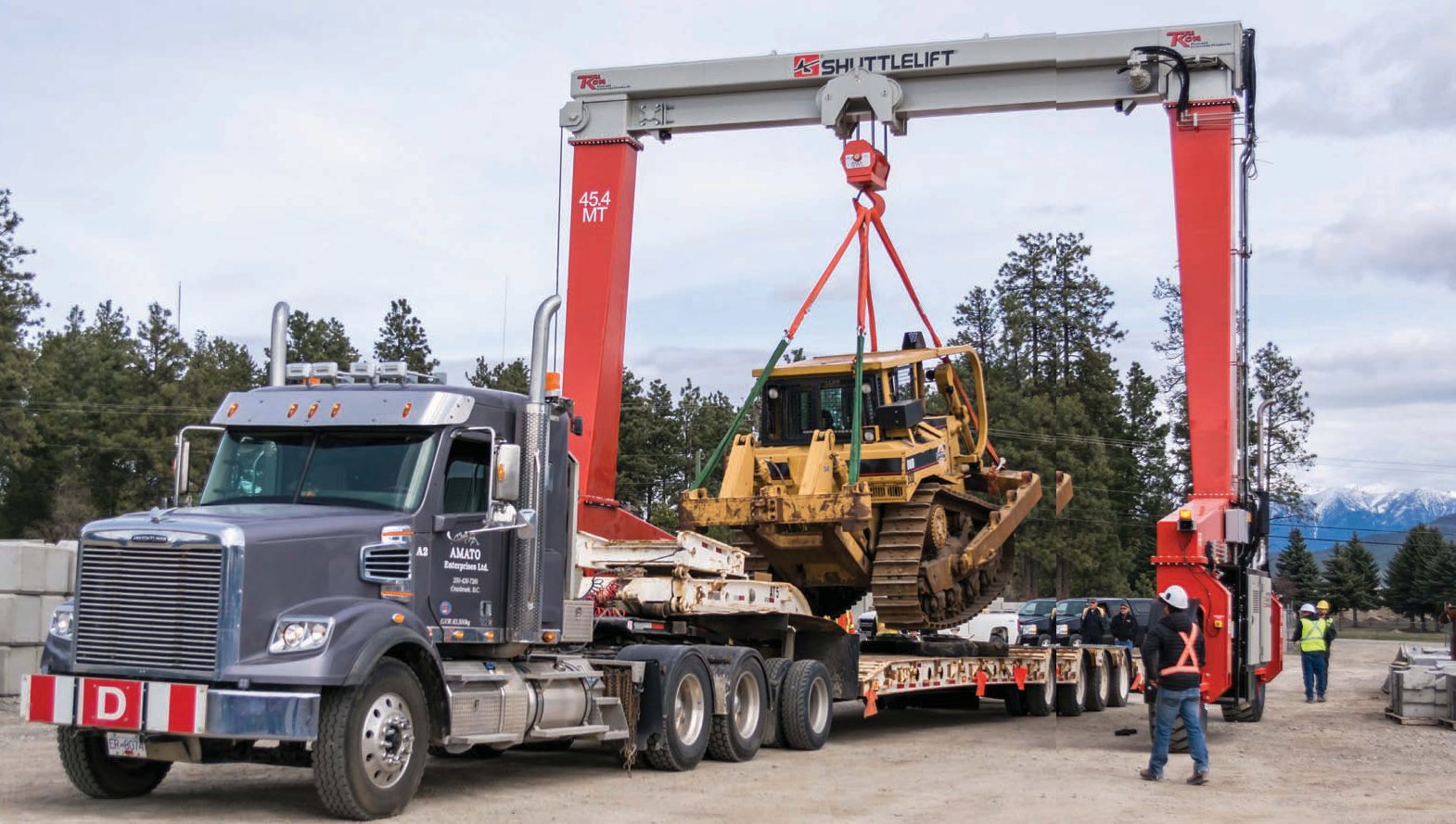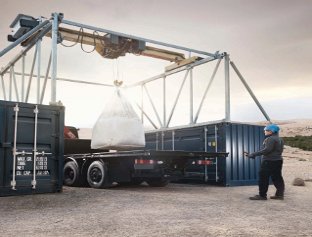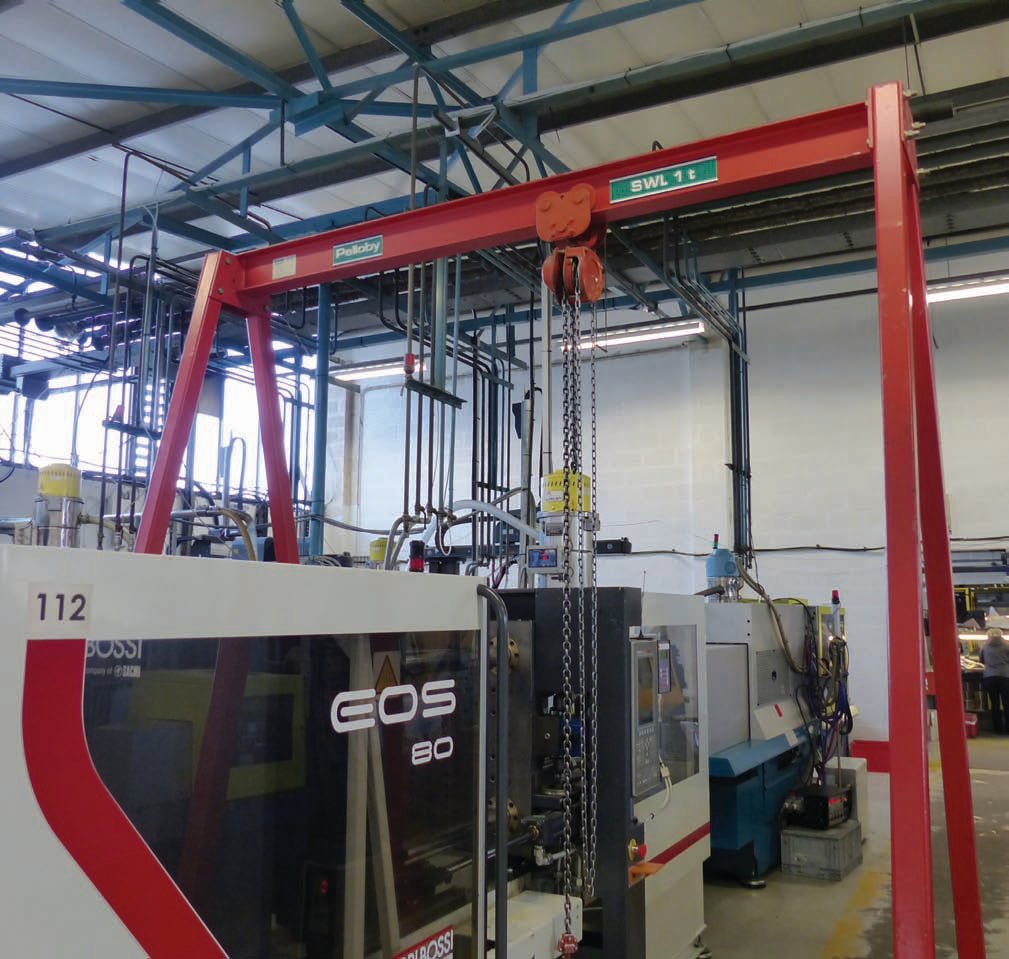Inside and out
5 October 2016Mobile gantry cranes bridge the gaps between factory, yard, and construction site. Bernadette Ballantyne looks at the potential of this technology.
There are a number of reasons why mobile gantry crane manufacturers are upbeat. For US firm Shuttlelift launch of its SB product line has exceeded expectations with customers using the cranes for applications that even the manufacturer hadn’t envisaged. The 15 to 120USt crane consisting of a single traversing beam and single hook was originally developed for tandem picking of long beams and girders but sales manager Kurt Minton says that the firm is seeing “more and more applications that are surprising us every day.”
Konecranes is seeing promising demand for its new CXT Explorer, a 6.3t portable mobile gantry crane that is competing with smaller mobile cranes in mining and construction related applications. Its popularity is helped by its competitive cost enabled by the use of the well established CXT crane system says Olli Kuismanen, general manager, business factory, Konecranes. “The CXT technology is so widely used that we can say for a price of a couple of months of mobile crane rental the customer can own this,” says Kuismanen.
In this report Hoist talks to US-based Shuttlelift, Finland’s Konecranes and the UK’s Pelloby about their mobile gantry offerings and finds out more about the applications and design features to learn why these cranes are maintaining strong demand in challenging market conditions.
NEW HORIZONS
The SB is one of four series of mobile gantry cranes offered by Shuttlelift. Its SL series is designed for low to moderate duty cycles for example picking and carrying a few loads per day. They range from 25USt up to 1,000USt capacity. The ISL series— a moderate duty cycle crane with a 30USt to 150USt capacity—is used largely by concrete pre-casters and steel fabricators making around 30 to 40 picks per day. Also with a moderate duty cycle is the DB series designed for use on firmer terrain such as asphalt or gravel.
Its capacity ranges from 30t to 150t. “Finally we have the SB series,” explains Kurt Minton noting that SB stands for single beam. “These are single beam cranes that are able to have a similar duty cycle to the ISL and DB,” he says they can operate on uneven and unimproved terrain, and they have been extremely popular since they were developed about 4 years ago. “We originally developed it for tandem picking of very long beams and girders with two cranes in conjunction and also for lifting very large pressure vessels. People were using an ISL or a DB to do similar work but they’d also have to then design a spreader bar to get to a single pick point, so we were looking at it from an economics standpoint in that the SB series would be more economical,” he says.
After its original launch in 2010 Shuttlelift observed customers using the cranes as expected, for tandem lifting of large beams, but there were other unexpected applications that soon emerged.
“What was unforseen was that people who used cranes indoors like regular overheads started looking at the SBs and thought we can create a shell building as the crane can move in and out and not just service one work bay or one building but multiple work bays and multiple buildings. So that was an unexpected market that has really taken off,” he says.
Another advantage that Minton points to is the cranes portability can lower the company tax burden because it is not part of the fixture and fittings or classed as a permanent building asset, and therefore it doesn’t raise the assessed value of the facility. “If you outgrow the facility you are not leaving this asset behind, you can just take it with you,” he says.
In terms of the cranes design it is a rubber-tyred gantry crane which comes with radio remote control as standard, which means it can be rigged by a single operator. “Every crane is completely mobile with full steering. You are able to move it anywhere within the shop. It has a pivot trunnion which is enables it to work well on very uneven terrain. It basically allows the two sides of the crane to be independent of one another as they go over dips and valleys,” says Minton.
Running on diesel, the cranes are hydraulic and the hoist is mounted at eye level to prevent the need for a manlift during inspections. The engine compartment is also designed so that all the filters are accessible from the ground. “The maintenance of the cranes is so simple, it is almost like maintaining your vehicle. All you need to do is make sure hydraulic and engine fluids are properly taken care of and also your tyre pressure is good, wire rope reeving is good. Other than that your daily maintenance is basically nothing,” says Minton.
Lift heights are flexible as the cranes are custom-built. “We have done hook heights anywhere from as low as 12ft (3.7m) all the way up to 45ft (13.7m) and that is the same for the width, we’ve done them as narrow as 12ft (3.7m) and as wide as 75ft (22.8m),” says Minton, who points out that almost every inquiry the firm gets surprises them with the innovation from the customers who have often seen the cranes in action at a competitor’s facility and have their own applications in mind. “I’ve been impressed by the steel vessel manufacturers because some of those are so huge in weight. We have a customer in Louisiana who is using two 120t SBs to lift the very huge vessels that he manufactures. He was doing it with crawler cranes and it was a very cumbersome process and this has drastically cut down the time it takes.”
He also points to a customer in California who switched to the SB cranes and shaved over two hours off the movement time with the entire lift taking 20 minutes. Machines are also being used in France, Germany, Asia, Australia as well as North America and Canada. “Canada has been a very good market. It has been a big surprise this year. The SBs are used in aerospace and the concrete industry. In fact there has been a remarkable increase in the concrete industry, this past fiscal year our concrete business has increased by 300%,” says Minton.
Steel fabrication too is seeing a lot of new users with customers who previously used overhead fixed cranes in their fabrication facilities before transferring the load to other cranes to move it to the door and then out into the yard. “With the SB crane it just comes right in the building, picks it up, drives it out, loads it or moves to staging area. This cuts down substantially on the material handling process for a lot of companies,” says Minton.
In terms of cost, Minton likens the crane’s price to similar capacity rough terrains, although he points out that a 30t SB crane can lift that 30t load anywhere beneath the frame. “When you need to lift 30t with a rough terrain crane you normally have to do that with a 50t crane because unless you are lifting that load 6ft from your centre line of rotation the load chart decreases dramatically so from that standpoint it is more cost effective.”
Minton says the past 18 months have been the busiest for the company and that they are already seeing increasing interest from North America thanks to the passing of the Fixing America’s Surface Transportation (FAST) Act at the end of 2015 which set out $305bn in transport investment for the next 5 years. However, he notes that competition has increased locally as well as in Europe and Asia.
Looking ahead he says that the company will continue to work on updating and improving their machines. “They are always customer-inspired. Updates for specific customers are then offered as options on future packages and that can be anything from special lighting to special edition packages for the engines, packages to deal with extreme cold.”
MADE TO MEASURE
“At Pelloby, every crane we produce is made-to-order featuring a bespoke design and this means the solutions we provide that come under the title mobile gantry can in fact vary enormously,” explains Pelloby marketing manager Jonathan Ferris. Typically, he says this refers to their A-frame cranes which usually span up to eight metres and stand at up to six metres. Load capacities start around the 100kg mark, but larger systems can lift considerably more than this.
In terms of key components of the cranes the main beam has a horizontal member fabricated from rolled steel fitted with end plates and cheek plates suitable for connection to the rolled hollow steel leg sections. Four swivelling castors are attached to the bottom of each A-frame leg section allow the system to be manually moved between work stations as required, which is the key advantage of this kind of system over its fixed counterpart, which Pelloby also also offer. “The trade-off for this manoeuvrability is that static systems are typically able to support larger capacities that mobile gantries,” says Ferris.
All of the A-frame mobile gantry cranes receive an undercoat of zinc phosphate primer and are then finished with an additional outer paint coating of the customer’s choosing. Pelloby also offers a range of optional extras with its mobile gantries to improve the system’s suitability for the job in hand as much as possible. These include manual and powered hoist travelling and hoisting motions, cast iron or poly tyred castors, castor locks, jacks, electrical isolators, air feeds, festoons, galvanised steel work for outdoor use.
Ferris says that applications vary massively as the crane is so flexible, however he says that one particularly common application is plastic-moulding machinery plants.
“The cranes are wheeled over the moulding machines to replace the tools being used inside for different production runs,” says Ferris. For example the company has supplied several cranes to a UK company called Small Plastic Parts over recent years. These include five and six tonne overhead models installed side by side, each designed to straddle an individual moulding machine. A further top running overhead crane with a two tonne capacity which spans the entire width of a major production room has also been erected and a series of small mobile A-frame gantry cranes have been supplied to give direct access to other pieces of machinery.
At the large scale end of the spectrum Pelloby also supplied a 20t capacity telescopic radio controlled portable gantry system to a Siemens facility at Port Harcourt in Nigeria. “This crane was a completely one of a kind bespoke design, with a host of interesting and unique features, but shares the same core benefit of being able to move around workplace obstacles to meet the company’s lifting requirements, while the gantry shape lets it straddle another piece of workplace equipment to achieve this,” says Ferris.
The 20t machine has a rack and pinion telescoping gantry. It stands at 5.7m when retracted to pass underneath a low lying doorframe, but it can extend to just over 7.5m in order to unload goods from above a wagon. The span of the crane is 4.5m. It has eight rubber gantry wheels, and an innovative end carriage system that allows a small degree of articulation in the wheel bogie assemblies to negotiate gradients of up to 7°.
It also came with four amber flashing beacons to signal to nearby staff when it’s in use and four emergency stop buttons to guarantee operator safety. “We can design bespoke cranes like this to meet literally any application,” says Ferris.
TAKING TO THE ROAD
The Konecranes CXT Explorer combines the CXT electric overhead wire rope crane with a tough steel structure sat atop of two standard ISO shipping containers. “The whole idea is to create a structure on top of which a standard industrial crane can be placed. The steel structure provides a fixed sturdy support for a volume product, the kind of crane used inside factories,” explains Olli Kuismanen, general manager, Business Factory, Konecranes. “This brings a couple of benefits. First the usage is very simple. When you press up it goes up and not like in boom type cranes where no matter what button you press it will always move in two directions. And of course being a volume product the CXT is very cost competitive so we didn’t have to create a new technical solution. We can just use the product range that we already have with the outdoor capabilities.”
Outdoor capabilities include rain covers, IP66 electrics, heat in the motors and electrics cabinet to avoid condensation. “It is the same components that we would use for normal gantry outdoor crane but if needed we can have any of the features from the CXT range,” he says explaining that inverter control , remote monitoring and many other features are available although the advanced features may not be very popular in this user segment.
“They want robust, simple, easy to use, systems that can be used anywhere,” he says.
It is these characteristics, along with the low price, that Kuismanen says are ensuring that the crane has been popular since its launch in March 2016, particularly in the mining and construction sectors. “It fulfils a popular need that customers are having as up until now they were using a mobile crane on a site for a long duration. Quite often these are rented for years and it can be quite costly,” he says explaining that the use of the tried and tested CXT crane means the company can keep the cost of ownership for the new Explorer low.
In terms of applications vehicle maintenance has been a big driver for this product with construction, mining and military vehicles all using the crane. “If a truck breaks down in a quarry and they have nothing to lift with, then either the truck needs to be hauled to a maintenance location or they need to bring in a crane to do the maintenance,” says Kuismanen. “In construction sites there are also a lot of operations where a crane is needed, for example for preassembly of machines,” he says and also points to logistical operations and loading and unloading of trucks as being another area of use.
Set up of the crane is 2-3 hours in normal transport mode when the lattice steel crane structure is already built. If the crane is being shipped inside the container and the lattice structure is also to be assembled then it can take 8-12 hours. “The record time for set up is 1 hr 15 minutes,” notes Kuismanen adding that the use of power tools accelerates the process compared to erection using hand tools. But whatever the transport mode or the tools available it will be up and running within a day of arrival, he says.
In terms of capacity the crane has a 6.3t lift ability (11,000lbs in the US), a 5m lift height and it moves in all 6 directions. Its area of cover is 6m along the long rail, and horizontally it moves along the 5m width between the containers. For transport and storage all of the components fit inside one of the standard ISO containers with some room to spare. Then after erection the container can be used as a fully equipped maintenance station. Although the crane is being sold globally the main markets so far have been the US and Europe. “We believe that there is definitely a need that hasn’t been fulfilled by the mobile crane concepts and we are certain that there is a market for this and we are seeing it,” says Kuismanen.
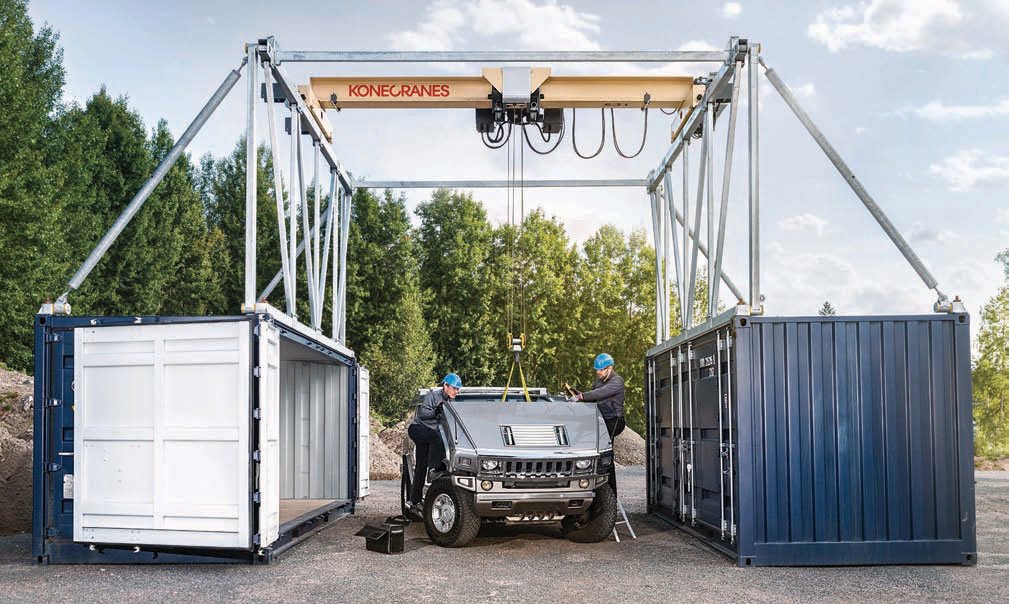 A 6.3t CXT Explorer being used as a temporary vehicle maintenance station, a much-needed solution for North American mining and construction users.
A 6.3t CXT Explorer being used as a temporary vehicle maintenance station, a much-needed solution for North American mining and construction users.
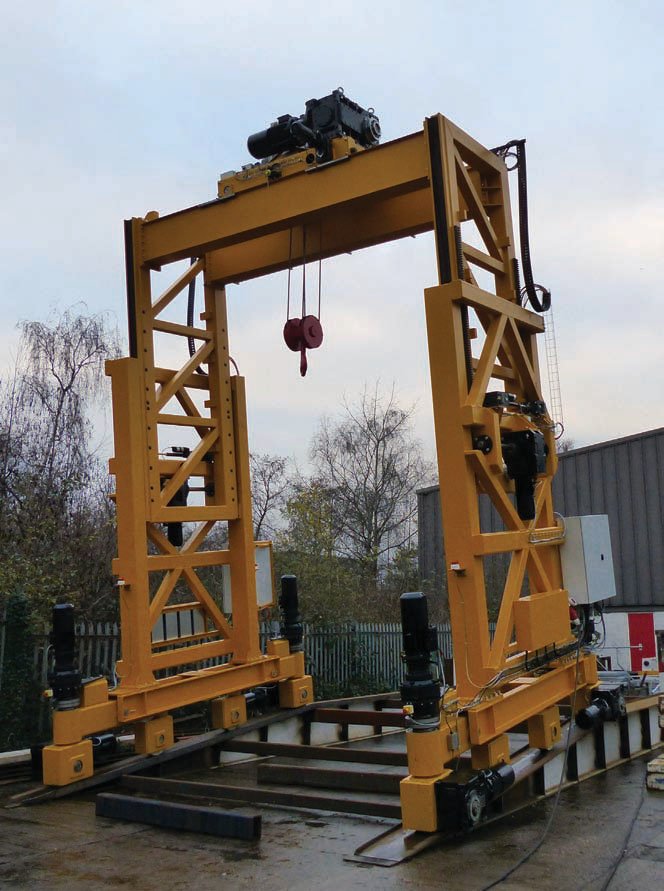 The Pelloby 20t telescopic radio controlled gantry crane can negotiate gradients of up to 7°. The transition is accommodated thanks to an innovative end carriage system that allows a small degree of articulation in the wheel bogie assemblies.
The Pelloby 20t telescopic radio controlled gantry crane can negotiate gradients of up to 7°. The transition is accommodated thanks to an innovative end carriage system that allows a small degree of articulation in the wheel bogie assemblies.
